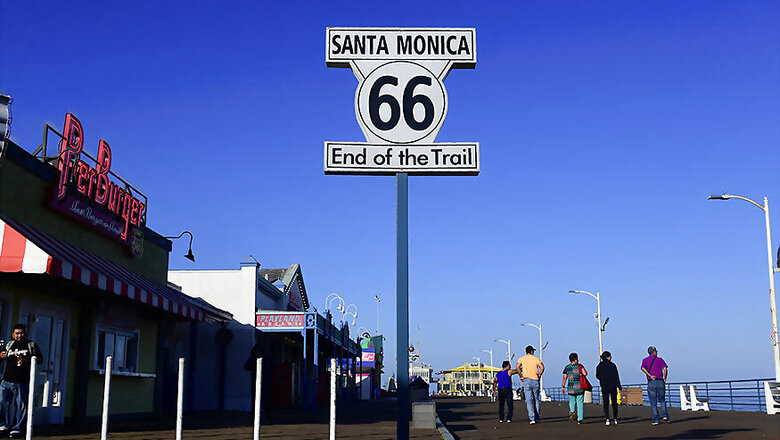
views
For decades, Route 66 captured the imagination of travellers the world over, offering a glimpse of a bygone era of American history, when people hit the road in search of adventure and a better life.
The two-lane highway established in 1926 and coined the "Mother Road" by John Steinbeck seemed to encompass the essence of America, threading through eight states from Chicago to Santa Monica.
But after it was decommissioned in the 1980s in favour of larger and faster thoroughfares, Route 66 appeared headed for the dustbin of history as the mum and pop stores, kitschy motels, diners and petrol stations that lined the road gradually shut down.
"Entire towns folded up and what had been a 2,400-mile (4,000 kilometres) carnival became to a large extent a 2,400-mile ghost town," explained David Knudson, founder and executive director of the non-profit National Historic Route 66 Federation.
In recent years, however, the iconic road that has been immortalised in countless books, movies, music ("Get your kicks on Route 66"), and a TV series has been experiencing a nostalgia-driven revival that is attracting tourists from around the globe.
"Foreigners come to travel the road because it gives them a chance to experience America before we became generic," said Michael Wallis, a historian and author of "Route 66: The Mother Road."
"It's still the road of adventure because nothing on Route 66 is predictable," he added. "I often say, 'You know what you are going to get at McDonald's ... but if you are on an old two-lane such as Route 66, you could go into a cafe, a greasy spoon, a pie place, a diner and you don't know what you're going to get.'"
Wallis said the fastest growing groups of tourists on Route 66 are Chinese and Brazilians, as well as Europeans drawn by the idea of the open space and the "road trip of a lifetime."
"I have clients in their 20s and 70s who are fascinated by this road and everyone is looking for convertible Mustangs and Harley Davidsons to experience it," said Zsolt Nagy, who twice a year organises Route 66 road trips that cost up to $8,000 per person.
"Business is booming, the roads are better, the signs are better, it's coming back to life," said Zsolt, who is from Hungary and who fell in love with the open road about 10 years ago when he travelled it. "I think the legend is growing like crazy."
Bob Russell, the mayor of Pontiac, about two hours south-west of Chicago, said his small community of about 12,000 people is a prime example of the resurgent interest in the road.
"It has been an amazing transformation," he said of the town which boasts four museums, 27 large murals and is considered one of the jewels of Route 66.
"There is a special aura for Route 66 to the overseas people because it represents freedom, the open road, your scarf around your neck and your hair blowing in the wind."
Driving today along stretches of the fabled highway -- 85 percent of which can still be travelled -- one can see renovated motels with blazing neon signs, newly opened museums, quirky sights and souvenir shops galore.
There are also half-abandoned communities and crumbling ghost towns that echo Steinbeck's epic 1930s novel of the great depression, "The Grapes of Wrath," the story of a family that embarks on a journey along Route 66, fleeing the Oklahoma dustbowl for California.
And while the road for many may evoke images of a more innocent America, as encapsulated in Norman Rockwell's paintings, Route 66 had a more sinister side for black travellers.
Half of the 89 counties that lined the highway were known as "sundown towns" where African Americans were banned after dark.
The author Candacy Taylor was researching a travel guide on Route 66 when she stumbled on "The Negro Motorist Green Book," which listed safe places along the road -- and notably revealed that the Ku Klux Klan ran Fantastic Caverns, a popular tourist attraction in Springfield, Missouri, and held cross burnings inside.
"All of the American narratives around what it means to hit the open road and the freedom and the symbolism that comes along with that was a dramatically different story for black people," said Taylor, who encourages people to "look beyond the bobby socks, the Chevys and the chrome" to experience the real Route 66.
"It's an American icon, just like Marilyn Monroe or Elvis," she said. "But Route 66 is not perfect and shiny, there are a lot of cracks in that metaphor, in that illusion of what America is."



















Comments
0 comment